 |
||||||||||
| February 4, 2004
In This Issue of The Acid Staining Newsletter News From the World of Concrete
One of the largest conventions in the world is the annual World of Concrete. This year it took place in Orlando, Florida from February 16-20. Last year over 75,000 people attended the convention, and this year I heard there were even more who came. Almost every hotel room in Orlando was taken, since it was held in conjunction with the World of Masonry. My company Faux Real was honored to be selected by Joe Nasvik and others at Hanley Wood, publishers of Concrete Construction magazine, to do a demonstration slab in the "Artistry in Concrete" section of the show. This was only the second year that the artistry demos have been a part of the show. As I understood, it was Joe's brainchild and his lobbying efforts and hard work which brought it about. Joe comes from a large family with its roots deep in concrete. His brother, Paul, has been staining concrete for decades and has developed some fantastic ways of using and splitting the stain colors, which I hope to write about in another newsletter. |
||||||||||
| The plan was that Joe would spread thick plastic sheeting over a large area of the back parking lot, construct 10 slabs, each ten by ten feet for the artists to use, and pour a very low-water mix of concrete containing super plasticizers, so that, only four days later, the slabs could be saw cut, topped, or stained with acid stains just like a slab which had cured for 28 days. He said that the surface would already be at 4,000 p.s.i. but that we would need to dilute our stains a good deal, since the plasticizers make the concrete more reactive to acid stain.
When we spoke on the phone I told him we wanted to try to make our slab as organic looking as possible. Most concrete artists stick with geometrical designs and I hoped to stand out from the crowd. I have always wanted a commission to do the floors of a natural history museum and took this as my golden opportunity to do a mock-up. I collected some small jawbones, some well-rusted flattened cans and a twisted loop of rusted barbed wire. I wanted multiple rib bones, but didn't have more than two deer ribs on hand. My clever assistant, Rae Kozai, spent one day at home fashioning imitation ribs out of polymer clay, called Fimo, which can be worked by hand and colored, then baked in the oven and hardened. (Many artists use it to make jewelry). While she was at it, she twisted small coils and flattened them to look like ammonite fossils. She bought a trilobite fossil at a rock shop and stamped round flattened blobs of the clay to look like trilobite impressions. Nothing was terribly accurate, but that's the fun of being an artist. We just wanted to give the general impression of fossils found in situ in a wall of terra-colored soil. I felt that if these "fossils" were pressed into the surface of the freshly-troweled slab and pushed down a bit, that would leave room for us to later cover them with a clear "window" of two-part quick-setting epoxy. We wanted the bones to be visible, but not protruding from the floor, as that would be impractical, creating trip hazards and dirt catchers. We hoped that once the slab was sealed with two coats of a solvent-based acrylic, the shininess of the entire slab would match that of the epoxy windows. Joe enlisted the help of Robert Harris and some artisans from the Scofield Company. Robert came up with the idea of creating the rough texture we wanted at the bottom edge of the slab by pressing plastic into the surface, troweling over it a bit, then lifting the plastic straight up. This created a wonderful, bumpy, non-skid surface which was more random and interesting than textures made with a store-bought plastic stamp or skin. Our ammonites were already embedded there and the texture enhanced them. We had good weather for staining the first day - cool and damp. On the third day of the demo, when we had to seal, the sun came out in full glory. Everything worked according to plan. Rae traveled with me to the conference and one of us would work while the other fielded questions and exchanged business cards with the observers, who were able to walk around most of the slabs and talk to the artists. I met many of you who take this newsletter and have studied my video. It was terrific fun to put faces with names from e-mails and to meet other stainers. Some of them gave us super ideas about what THEY are doing, which we will try out and pass on to you as time permits. |
||||||||||
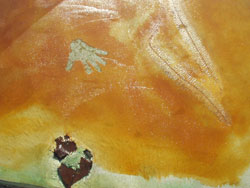 |
||||||||||
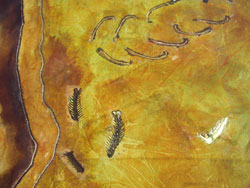 |
||||||||||
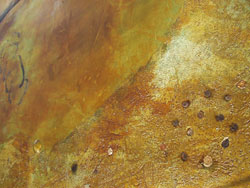 |
||||||||||
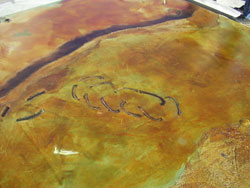 |
||||||||||
 |
||||||||||
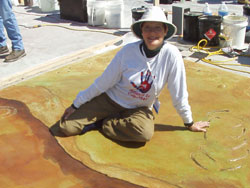 |
||||||||||
|
I have never had so much fun working on a concrete project. It is a shame that our masterpiece could not be hoisted to a vertical position and placed into part of a large concrete wall. It would have been perfectly suited for a garden. As it was, Joe had to bulldoze all of the artist's slabs, break them into pieces, and cart them to the dump when the show was over. The photos shown here are detail views I was able to get with a small digital camera. A professional photographer took shots from a ladder on the final day to get an overall photo of each artist's slab. These will be in the April issue of Concrete Construction magazine. There were some simply amazing artists there, so don't miss that issue! My first seminar is being held this weekend and my crew and I are very excited. We have lots planned and I'll be sure to let you know how everything goes in my next newsletter. There is still space available for my 'Advanced' seminar in April and for both my seminars in June, but they are filling quickly so let us know if you are even interested. Click here for more info about my upcoming seminars. Questions or comments about my newsletter? |
||||||||||
|
|
||||||||||
